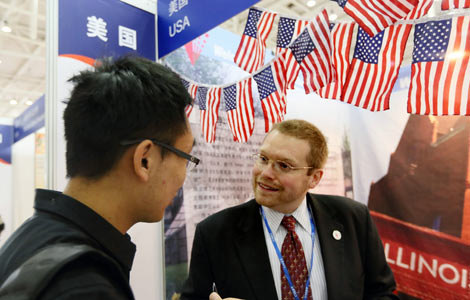Chinese students in US jump 21%
Updated: 2013-11-11 12:36
By Chen Weihua in Washington (China Daily USA)
|
||||||||
While enrollment from India and South Korea are both in decline
China continues to be the top source driving the growing and record number of international students in US universities and colleges.
During the 2012/13 academic year, Chinese student enrollments increased by a hefty 21.4 percent to 235,597, compared with the 194,029 in the previous academic year, according to the 2013 Open Doors Report on International Educational Exchange by the Institute of International Education (IIE).
Overall, the number of international students enrolled in US establishments of higher education in the 2012/13 academic year rose 7.2 percent to 819,644 students, or about 55,000 more than the previous school year.
Of all international students in the US, 28.7 percent were from China. The rise in the number of undergraduate students from China was especially dramatic, jumping 26 percent in the 2012/13 academic year.
A breakdown shows that 39.8 percent of Chinese students in the US were undergraduates while 43.9 percent were graduates. The remainder included 10.2 percent in Optional Practical Training (OPT) and 6.1 percent in other programs. OPT is a US policy for international students on F-1 visas to work in the US for one year after graduation to get practical training to complement their field of study.
Several other countries, such as Brazil and Saudi Arabia, have also seen large increases.
The report shows that students from the top three countries of origin - China, India and the Republic of Korea - now account for 49 percent of the total number of international students in the US. But China was the only of the top three with its numbers increasing, as enrollments from India and the ROK both declined.
Aside from these top three, no other country accounted for more than 5 percent of the total, according to the report.
The number of Chinese students in the US started to grow in the 1980s. In the 1988/89 school year, the Chinese mainland displaced Taiwan as the leading supplier and held that position until it was displaced by Japan in 1994/95. In 1998/99, China again became the leading source of foreign students for three years until it was replaced by India. But that top position has again been taken back and held by China since 2009/10.
With a fast-growing economy and middle class, more and more Chinese families are able to send their children abroad.
These 2012/13 data mark the seventh consecutive year that Open Doors has reported an expansion in the total number of international students enrolled in higher education in the US. There are 40 percent more international students studying at US colleges and universities now than a decade ago, and the rate of increase has grown steadily over the past three years.
The report said the growth is likely to continue following a strong increase in the so-called "new international students", those enrolling for the first time in the fall of 2013. The new enrollment in 2012/13 went up 10 percent from the prior year, following a 7 percent increase in 2011/12.
Growth of both enrollment and new enrollment had fallen since the economic slowdown of 2008.
Despite the increase in recent years, international students still make up less than 4 percent of the more than 21 million students enrolled in US higher education.
Besides India and the ROK, several other places of origin - such as Japan, Hong Kong and Taiwan - also sent fewer students to US universities and colleges.
The report suggests the decline was likely caused by a mix of global and home country economic factors, improving higher education opportunities at home and strengthening employment opportunities at home following graduation.
International students contributed more than $24 billion to the US economy last year, through payment of tuition, housing and other costs, according to the US Department of Commerce.
"International education promotes the relationship building and knowledge exchange between people and communities in the United States and around the world that are necessary to solve global challenges," said Evan Ryan, US assistant secretary of state for education and cultural affairs, during a conference call.
"The connections made during international education experiences last a lifetime," said Ryan, who studied abroad herself in the early 1990s.
"International students enrich classrooms, campuses and communities in ways that endure long after students return to their home countries.
"We encourage US schools to continue to welcome more international students to their campuses and to do more to make study abroad a reality for all of their students," she said.
The Open Doors report also found that during the 2011/12 academic year, 283,332 American students studied abroad for academic credit, an increase of 3 percent from the previous year. However, the report did not count those who went for short-term and no-credit study abroad.
Trailing Britain, Italy, Spain and France, China was the fifth destination for American students going overseas. Two percent more students studied in China during the 2011/12 year over the previous year.
In all, 14,887 US students studied in China during the academic year, a rise of 2 percent from the previous year and accounting for 5.3 percent of the total US students studying abroad.
chenweihua@chinadailyusa.com
(China Daily USA 11/11/2013 page1)
- SUNY recruiting Chinese students
- More Chinese students return to find work after studying abroad
- Fewer Chinese students apply to US graduate schools: report
- Exploratory team to study conditions for Chinese students in US
- Chinese students boost boarding business in US
- Chinese students head overseas at younger ages
- Medical insurance for overseas Chinese students
Most Viewed
Editor's Picks

|

|

|

|

|

|
Today's Top News
Real-estate bubble seen bursting in China, US
More Chinese students going to US
Online shopping gala sets records
Typhoon Haiyan claims 6 in S. China
Reform to dominate talk at plenum
Family planning policy to be improved
Deleveraging eases loan growth
DC-Beijing relations need transparency: experts
US Weekly

|

|













